MasAgro offers “genetic insurance” for maize and wheat
By Ricardo Curiel /CIMMYT
CIMMYT work in Mexico could provide safeguards against climate change challenges.
By Ricardo Curiel /CIMMYT
CIMMYT work in Mexico could provide safeguards against climate change challenges.
By Vijay Chaikam/CIMMYT
The Sustainable Modernization of Traditional Agriculture —or MasAgro— program organized a five-day training in El Batán this month to develop skills in the use of new technologies to increase maize productivity in Mexico.
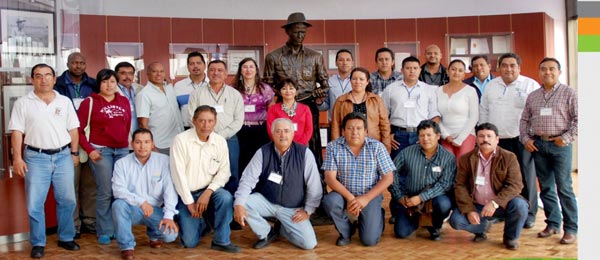
MasAgro is a collaboration between CIMMYT and Mexico’s Ministry of Agriculture, Livestock, Rural Development, Fisheries and Food (SAGARPA). Eighteen specialists from national seed companies attended, as well as two scientists from public institutions and research assistants from CIMMYT’s Global Maize Program. Scientists from the program and specialists from the Biometrics and Statistics Unit spoke on maize breeding. Researchers working in tropical, subtropical and highland areas described their methods to improve and evaluate germplasm. The presentations highlighted the superior CIMMYT germplasm for agroclimatic zones in Mexico.
Specialists addressed the identification of diseases and different approaches to manage them; improving diseaseresistant germplasm; techniques for evaluating traits such as low nitrogen and drought tolerance; the use of molecular markers and genomic selection; phenotyping methods; and statistical analysis of phenotypic and genotypic data. Discussions also addressed the importance of nutritional quality and the evaluation of quality characteristics.
The last three days centered on doubled haploid technology, which allows accelerated development of inbred lines, featuring theoretical and practical sessions. The maintenance of the haploid inducer and seed production methods were shown during the visit to the El Batán experiment station. The visit also provided firsthand information on the use of doubled haploid lines in CIMMYT’s highland breeding program. At the Agua Fría experiment station, workshop participants visited the facilities for doubling chromosomes. Practical demonstrations emphasized staff safety and the careful management of waste generated during chromosome duplication.
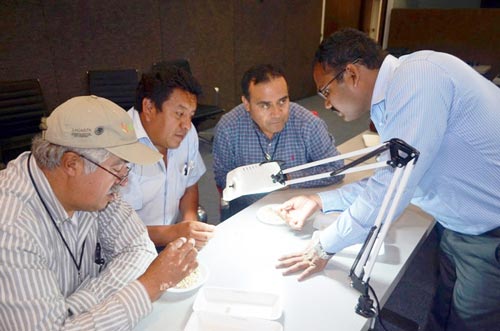
Participants also saw induction nurseries and the phenotypic evaluation of doubled haploid lines. A field trip to the experimental site of the National Institute for Forest, Agriculture and Livestock Research (INIFAP) – Celaya showcased the agronomic management of a treated haploid nursery (D0) and the use of doubled haploid lines in INIFAP’s maize breeding program.
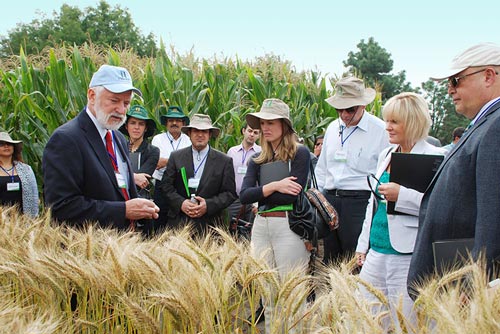
Mexico is pleased with the role of CIMMYT in national agricultural development and with the synergies that have arisen through the initiative MasAgro – the Sustainable Modernization of Traditional Agriculture, said Belisario Domínguez Méndez, Director General for Productivity and Technological Development of Mexico’s Secretariat of Agriculture, Livestock, Rural Development, Fisheries and Food (SAGARPA). “The government feels very proud that MasAgro is not only part of Mexico but is now sharing results with other countries,” said Domínguez, opening the 2013 Ambassadors Day event in El Batán, Mexico, on 10 October, on behalf of Mexican Secretary of Agriculture Enrique Martínez y Martínez. “The partnership with CIMMYT is a fundamental strategy for our country.”
Launched in 2010 and coordinated by SAGARPA and CIMMYT, MasAgro is helping strengthen national food security through research, capacity building and the transfer of technology for rural areas. Partners develop and promote the adoption of cuttingedge knowledge and practices among small- and intermediate-scale farmers of maize, wheat and small grains, to improve their incomes and mitigate the effects of climate change in Mexico. Ambassadors Day participants included members of the diplomatic corps in Mexico of 20 nations – including countries where CIMMYT works – as well as representatives of the United Nations Educational, Scientific and Cultural Organization (UNESCO), the Inter-American Institute for Cooperation in Agriculture (IICA), SAGARPA, the Technical and Scientific Cooperation Division of Mexico’s Foreign Affairs Secretariat (Secretaria de Relaciones Exteriores, or SRE) and CIMMYT staff.

The day’s program featured discussions, lab and field tours and expert briefings on CIMMYT activities and outputs, such as maize and wheat genetic resources, wheat disease resistance breeding and bread wheat quality and maize breeding and biofortification. CIMMYT staff from the home countries of the visiting dignitaries were on hand to answer questions and offer hospitality. At a gala luncheon, the debut presentation of a new general video on CIMMYT aired to many favorable comments. In his address to the visitors, CIMMYT Director General Thomas A. Lumpkin emphasized that an expanding population, changing diets, limited natural resources, demand for bio-fuels and increasingly variable climates are all putting extraordinary pressure on the global food system. “In summary, we will have huge demand for food crops coupled with worsening conditions for crop production,” Lumpkin said. “This highlights the need for improved technology.” The Ambassador of Palestine, Munjed M.S. Saleh, was impressed by CIMMYT´s presentation and said his country is already giving several countries technical support to improve water-use efficiency. He indicated that he is arranging a visit for his Minister to Mexico, and, if confirmed, will include a visit to CIMMYT.
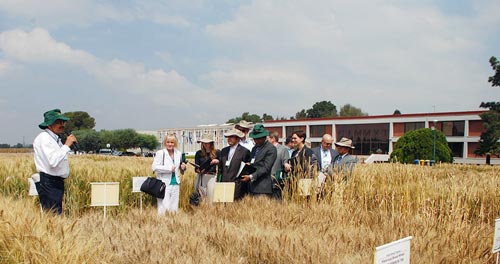
The representative of the Embassy of Venezuela, Alba Mendez, expressed interest in working with the country’s ambassador to propose collaborating with CIMMYT to strengthen agricultural research in Venezuela. She also said she is interested in a training program for farmers. Other ambassadors and representatives wrote to Isabel Peña, Head of Latin America Institutional Relations and event organizer, to say they were impressed by the professionalism and organization of the event and learned about CIMMYT’s impact worldwide. Peña thanks all support staff, scientists and directors who presented to or interacted with the visitors. She said collaboration with other countries and institutions are strengthened by events like this one.
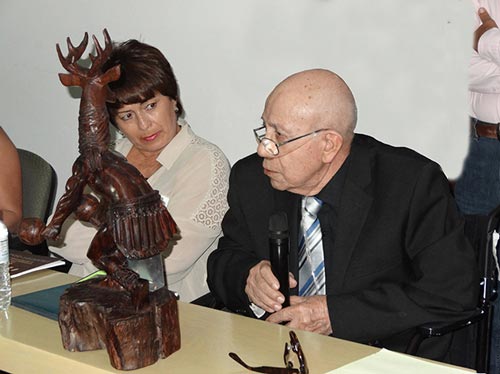
Retired CIMMYT scientist Alejandro Ortega y Corona was honored for his 59 years of maize research at the Meeting for the Coordination of Investigation of Drought Tolerance in Maize from 5 to 6 August. Ortega received recognition for his work with CIMMYT and Mexico’s National Forestry, Agricultural, and Livestock Research Institute (INIFAP) at a special meeting of the Biodiversity Project of Mexico and CIMMYT’s Sustainable Modernization of Traditional Agriculture (MasAgro) initiative in Ciudad Obregón, Sonora State, Mexico.
Kevin Pixley, director of CIMMYT’s Genetic Resources Program, extended thanks and gratitude for the 23 years Ortega served in the organization’s maize program in the areas of entomology, physiology, breeding and pathology. Pixley read letters sent by former CIMMYT maize physiologist Greg Edmeades and Marianne Bänziger, deputy director general for research and partnerships, who worked closely with Ortega in developing drought and heat tolerant maize varieties. A Yaqui dancer statue was presented to Ortega to honor his years of hard work, dedication and leadership at CIMMYT. INIFAP’s Salvador Fernandez and Rafael Ariza congratulated Ortega for his service and dedication.
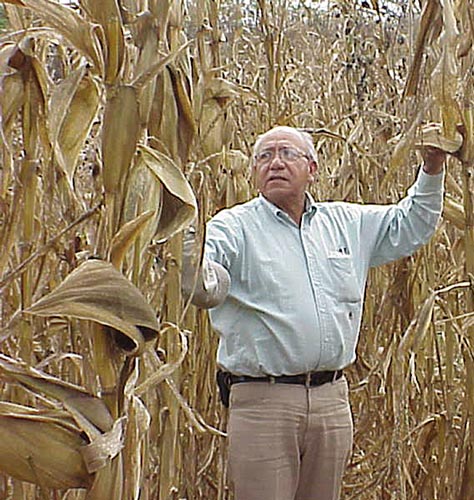
Erasmo Valenzuela Cornejo, director of INIFAP’s Northwest Regional Research Center of spoke about Ortega’s accomplishments and contributions, among them the mass rearing of insects for CIMMYT maize breeders, QPM maize and screening for heat and drought tolerance. Ortega produced the heat tolerant hybrid H431, which continues to be the number-one hybrid in commercial production for summer plantings in southern Sonora. More than 40 INIFAP scientists, including regional directors and research station superintendents, attended the meeting, as well as five CIMMYT scientists. Scientists working on drought or heat tolerance in maize from other institutions, including the University of Nuevo Leon, Antonio Narro Agrarian Autonomous University and the maize seed company Pioneer–Mexico, also attended the meeting.
Martha Willcox and Gilberto Salinas from MasAgro- Biodiversity organized the meeting to coordinate research evaluating maize accessions from both INIFAP and the CIMMYT germplasm bank, which were collected in arid areas under controlled drought trials to identify new sources of drought resistance. The expansion of infrastructure to conduct large-scale replicated trials on INIFAP stations was a main topic of discussion. Salinas gave an overview of the MasAgro Biodiversity project and Willcox explained the specific objectives for drought and heat phenotyping under the project.
Juan Manuel Hernández and Ariel Ruíz from INIFAP gave a history of the recent INIFAP maize collection, which Ortega coordinated on a national level, and the selection within that collection for semiarid races based on GPS and climatic data. Samuel Trachsel, maize physiologist, explained CIMMYT’s methods of evaluating drought tolerance as well as the infrastructure and equipment needed. Trachsel also spoke about site requirements and precipitation and temperature profiles provided by Kai Sonder to best select sites for development. Juan Burgueno and Willcox spoke on genetic variation within accessions and experimental design.
By Miriam Shindler/CIMMYT
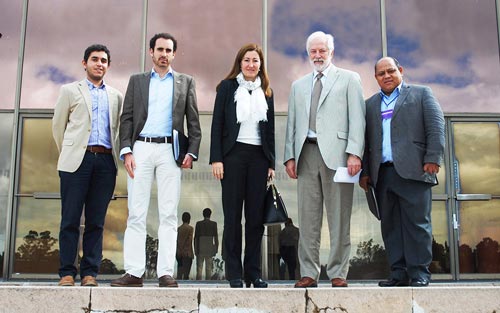
Representatives of the Food and Agriculture Organization of the United Nations (FAO) and the Strategic Project for Food Security (PESA) visited CIMMYT’s headquarters in El Batán to discuss collaborative opportunities and tour the Germplasm Bank and the Conservation Agriculture trial plots on 12 September.
Thomas A. Lumpkin, director general of CIMMYT, and representatives of the Sustainable Modernization of Traditional Agriculture (MasAgro) program met with Nuria Urquía, FAO representative in Mexico, and Julio César Rosette Castro, director general of PESA. The leaders shared information on their work in Mexico and expressed an interest in making concerted efforts to contribute to Sin Hambre – the National Crusade Against Hunger program. The aim of this cooperation is to strengthen synergies between the two institutions to increase the productivity of subsistence farmers in Mexico.
To find out more about MasAgro in either English or Spanish, visit MasAgro. Sin Hambre – the National Crusade Against Hunger – is a national strategy to guarantee food security and better nutrition for 7.4 million Mexicans who live in conditions of extreme poverty.
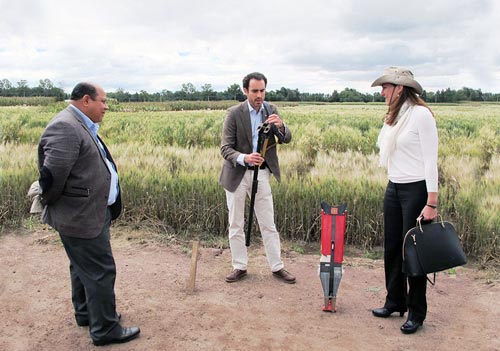
Urquía welcomed the meeting as an opportunity “to strengthen the collaboration between CIMMYT and the FAO and to form future partnerships that will strengthen the work for farmers in marginalized areas.” According to Lumpkin, “CIMMYT, the FAO and PESA are working towards a collective goal of increasing agricultural production, reducing hunger and extreme poverty in Mexico. Working together as part of the National Crusade Against Hunger will lead to a greater exchange of technologies and information that will benefit Mexican famers.” CIMMYT maintains one of the largest wheat and maize germplasm bank in the world, with 28,000 accessions of maize and more than 140,000 accessions of wheat.
Funded by the Japanese government, the state-of-the-art center has a storage capacity of more 450,000 seed samples and is one of only three germplasm banks globally to achieve ISO certification (and the first outside of Europe). MasAgro is financially supported by Mexico’s Ministry of Agriculture, Livestock, Rural Development, Fisheries and Food (SAGARPA).
By Brenna Goth, CIMMYT
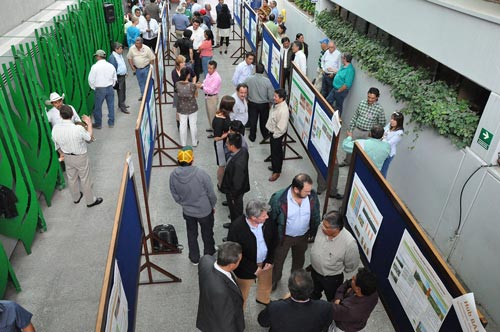 Husband-and-wife duo Oscar Hernández Mendoza and Rosa Elena Montiel Díaz said their work with MasAgro helps them improve the lives of farmers in their town. The two made a presentation about their efforts in Úrsulo Galván, Veracruz, on 29 August during CIMMYT’s first symposium for MasAgro experimental platforms. MasAgro, or the Sustainable Modernization of Traditional Agriculture, is a CIMMYT program coordinated with Mexico’s Ministry of Agriculture, Livestock, Rural Development, Fisheries, and Food (SAGARPA).
Husband-and-wife duo Oscar Hernández Mendoza and Rosa Elena Montiel Díaz said their work with MasAgro helps them improve the lives of farmers in their town. The two made a presentation about their efforts in Úrsulo Galván, Veracruz, on 29 August during CIMMYT’s first symposium for MasAgro experimental platforms. MasAgro, or the Sustainable Modernization of Traditional Agriculture, is a CIMMYT program coordinated with Mexico’s Ministry of Agriculture, Livestock, Rural Development, Fisheries, and Food (SAGARPA).
MasAgro aims to help small-scale farmers implement sustainable farming practices and introduce new technology to help increase their maize and wheat yields. The symposium brought together more than 50 collaborators from different parts of Mexico who are working with MasAgro to increase sustainability, improve yield and lower costs for small-scale farmers. Attendees at the El Batán event saw posters on the various projects and talked with the collaborators about their results. “It has been an opportunity for them to exchange their work,” said Yesenia Soto, who works in training for MasAgro. Posters explained outcomes and future plans from Morelos, Oaxaca, Sonora and Yucatán and other states with crops ranging from maize and wheat to chia and beans. Hernández and Montiel, founders of Grupo Hernádez Montiel, are working with MasAgro to bring new technology to their region and raise maize yields by training farmers. So far, the group has been successful in helping farmers produce more, Hernández said. “We can’t work alone,” he said. “It’s for our people, our producers.”
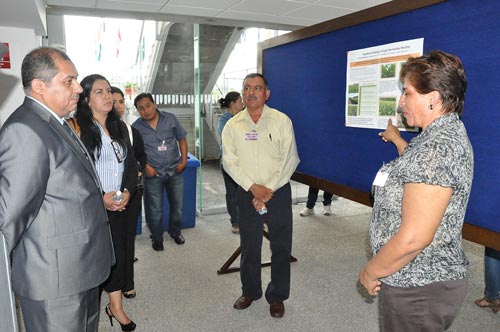 Jesús Rafael Valenzuela Borbón came to the symposium from Navojoa, in southern Sonora. He is trying to bring conservation agriculture practices to farmers in an area where the main problem is a lack of water. Valenzuela is in charge of an experimental site where he is growing maize and wheat using crop rotation. Use of such practices in the area is minimal, though Valenzuela is looking for support to implement them more widely, he explained. “All of the results are very favorable,” he said.
Jesús Rafael Valenzuela Borbón came to the symposium from Navojoa, in southern Sonora. He is trying to bring conservation agriculture practices to farmers in an area where the main problem is a lack of water. Valenzuela is in charge of an experimental site where he is growing maize and wheat using crop rotation. Use of such practices in the area is minimal, though Valenzuela is looking for support to implement them more widely, he explained. “All of the results are very favorable,” he said.
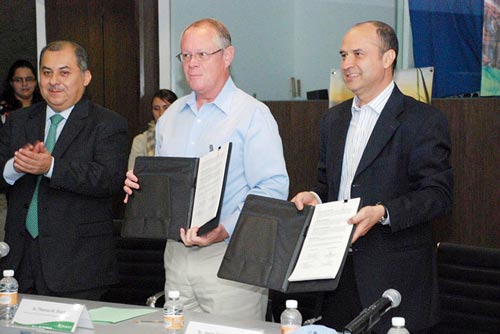
CIMMYT and leading agribusiness Syngenta México signed an agreement this month to work together in efforts aimed at sustainably increasing crop production in Mexico while protecting the environment and contributing to food security.
Syngenta will collaborate with CIMMYT to do research on conservation agriculture in four experimental platforms. The new project follows the same logic and goals of MasAgro, the Sustainable Modernization of Traditional Agriculture, which CIMMYT implements in coordination with Mexico’s Ministry of Agriculture, Livestock, Rural Development, Fisheries, and Food (SAGARPA). MasAgro aims to build the capacities of small-scale farmers to encourage the adoption of sustainable farming practices and technologies that may help increase maize and wheat output, in line with Mexico’s recently announced “Crusade Against Hunger.”
The three-year agreement will focus on improving maize productivity, generating more income for farmers, protecting natural resources, and combining Syngenta’s expertise with local knowledge to work directly with farmers. Syngenta and CIMMYT will also develop joint research protocols and offer courses in crop protection and adequate use of agrochemicals.
Soil conservation and protecting the biodiversity of undergrowth, small animals and beneficial insects will be another focus of the agreement. Both organizations have also expressed their interest in improving communication and information technologies (ITCs) in the agricultural sector.
Representatives from Syngenta and SAGARPA visited CIMMYT’s El Batán campus to see its conservation agriculture trial plots and germplasm bank before signing the agreement on 14 August 2013. Javier Valdés, Director General of Syngenta México, said during the ceremony that the agreement shows the company’s commitment to food security and sustainability. “We will continue to promote the formation of important publicprivate partnerships like the one we’re celebrating today to increase the productivity of crops like maize and wheat, which will help with economic, social and environmental development in rural communities in the country,” he said.
CIMMYT has worked on projects with Syngenta in the past. This new collaboration has been developing for years and is an example of cooperation between an international research organization and a private business. Scientific collaboration is essential for making maize production in Mexico sustainable and profitable for resource-constrained farmers, said Bram Govaerts, Deputy Director of CIMMYT’s Global Conservation Agriculture Program.
Govaerts said he thought the new partnership would have the same success as other CIMMYT programs worldwide. Belisario Domínguez, the director general of productivity and technological development for SAGARPA, said the vision of MasAgro is essential to the government’s national fight against hunger. Domínguez congratulated the two groups for forming the alliance and said that similar projects will promote the growth of the agricultural sector.
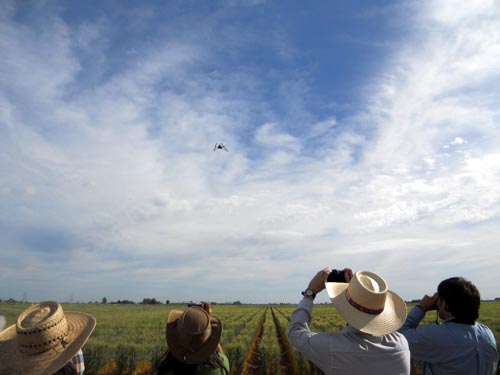 Over 100 stakeholders, scientists, and students from 28 countries were welcomed in Obregon, Mexico, by John Snape, CIMMYT Board of Trustees member, as he opened the 3rd International Workshop of the Wheat Yield Consortium (WYC). The meeting sponsored by SAGARPA (through MasAgro) was held at the Campo Experimental Norman E. Borlaug (CENEB) near Ciudad Obregon, Sonora, Mexico, during 5-7 March 2013.
Over 100 stakeholders, scientists, and students from 28 countries were welcomed in Obregon, Mexico, by John Snape, CIMMYT Board of Trustees member, as he opened the 3rd International Workshop of the Wheat Yield Consortium (WYC). The meeting sponsored by SAGARPA (through MasAgro) was held at the Campo Experimental Norman E. Borlaug (CENEB) near Ciudad Obregon, Sonora, Mexico, during 5-7 March 2013.
Following the welcoming speech, Vicky Jackson (BBSRC) updated stakeholders on the current status of the new Wheat Yield Network (WYN) that supercedes the WYC with a plan to expand the funding basis and research agenda. CIMMYT wheat physiologist Matthew Reynolds then provided an overview of the current wheat yield situation: “Although production has increased steadily, the price of wheat continues to increase at a considerably faster rate.” WYN is an international network of scientists working together to address these issues. As wheat productivity will be crucial for food security in the future, WYN aims to achieve a 50% increase in genetic yield potential of wheat within 20-25 years through (1) increasing crop biomass by improving photosynthetic capacity, (2) optimizing partitioning to maximize agronomic yield, and (3) incorporating improved yield potential traits into elite breeding lines adapted to wheat agro-ecosystems worldwide. “We are establishing a balanced research portfolio with a strong output oriented agenda to provide solutions for wheat farmers and consumers throughout the developing world,” said Reynolds.
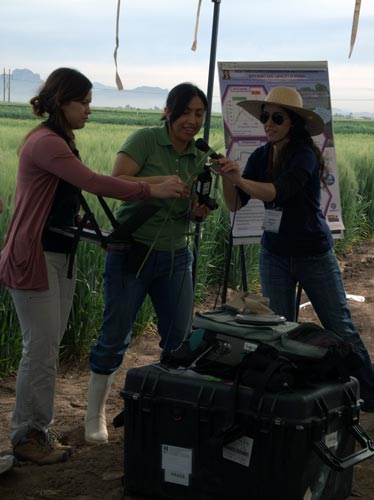 The first day was dedicated to over 20 presentations covering all three major research areas. Chaired by Bill Davies (Lancaster University), the session on crop biomass improvement covered topics such as optimizing leaf and canopy photosynthesis and photosynthetic potential of spikes. Gemma Molero (CIMMYT) pointed out that while the importance of spike photosynthesis has been recognized for 50 years, no breeding programs has yet tried to systematically improve this trait. This session was followed by presentations on partitioning optimization chaired by Martin Parry (Rothamsted Research), and the day was concluded with updates on breeding for yield potential and research support platforms which was chaired by Bill Daniel Calderini (Universidad Austral de Chile).
The first day was dedicated to over 20 presentations covering all three major research areas. Chaired by Bill Davies (Lancaster University), the session on crop biomass improvement covered topics such as optimizing leaf and canopy photosynthesis and photosynthetic potential of spikes. Gemma Molero (CIMMYT) pointed out that while the importance of spike photosynthesis has been recognized for 50 years, no breeding programs has yet tried to systematically improve this trait. This session was followed by presentations on partitioning optimization chaired by Martin Parry (Rothamsted Research), and the day was concluded with updates on breeding for yield potential and research support platforms which was chaired by Bill Daniel Calderini (Universidad Austral de Chile).
The following day participants had the opportunity to visit the Mexican Phenotyping Platform (MEXPLAT) located at CENEB for a field day and presentations on wheat yield potential and wheat yield and stress adaptation. There they had the chance to see CIMMYT’s first blimp, which was launched during last year’s workshop, and observe the new airborne remote sensing platform AscTec Falcon 8 in action, as well as other tools used by CIMMYT PhD students and physiologists in their research. “For me all the presentations were interesting,” said Yosra Ellemsi, agronomist and CIMMYT conservation agriculture program trainee from Tunisia, showing that the workshop did not target only physiologists. “I was particularly interested in the presentation of Sean Thompson who used the ground penetrating radar as a phenotyping tool for roots. This tool is fascinating firstly because it allows for nondestructive ground penetration, and secondly because it could help breeders to phenotype and select optimal root biomass in breeding populations.” At the end of the program, Davies thanked Reynolds and his team for organizing the workshop and for their work to achieve the goals of WYC: “We believed in this when we first started talking about it and you have moved it forward. This workshop is a great opportunity to discuss the latest developments in the field as you always get to talk to very interesting scientists.
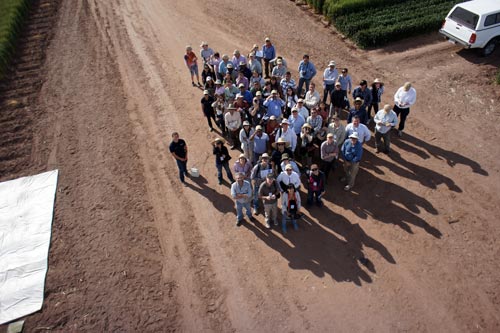
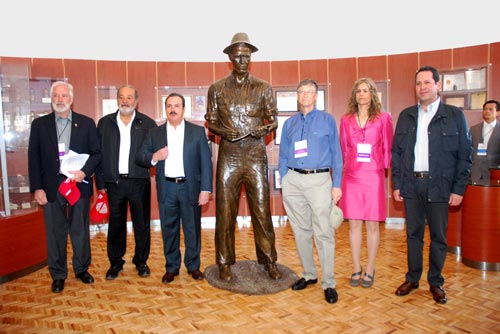 On 13 February 2013, CIMMYT inaugurated a new US$ 25 million research complex at its headquarters in El Batán. The new advanced bioscience research facilities, 45 kilometers (20 miles) from Mexico City, marked its grand opening to a crowd of more than 100 invited guests.
On 13 February 2013, CIMMYT inaugurated a new US$ 25 million research complex at its headquarters in El Batán. The new advanced bioscience research facilities, 45 kilometers (20 miles) from Mexico City, marked its grand opening to a crowd of more than 100 invited guests.
The event was attended by Bill Gates, Carlos Slim, Lic. Enrique Martínez y Martínez, Mexican Secretary of Agriculture and leader of the Ministry of Agriculture, Livestock, Rural Development, Fisheries and Food (SAGARPA), and Dr. Eruviel Ávila Villegas, Governor of the State of Mexico.
The new bioscience complex will allow researchers to speed the development of valuable seed, by way of more precise characterization of its genetic traits, such as heat and drought tolerance, disease and pest resistance, and seed health, as well as the nutritional and industrial quality of the grain. CIMMYT was the cradle of the Green Revolution 60 years ago. By providing cutting-edge facilities and an enhanced research capacity, this alliance will significantly improve farm productivity.
“We are enthusiastic about this alliance,” said Bill Gates, co-founder of the Bill & Melinda Gates Foundation. “Bringing together the collective experience of our respective organizations, we can promote innovation to transform the lives of farmers in Mexico and around the world. Investing in agricultural development is one of the most effective investments we can make. It allows farming communities to become self-sufficient and prosperous by growing and selling more of what they produce.”
Carlos Slim added: “This alliance to promote research and development by CIMMYT, with the collaboration of national and international scientists dedicated to improved seed and generating more efficient techniques, is a step toward making this knowledge available to farmers everywhere, particularly small- and intermediate-scale farmers, as well as promoting economic growth, employment, and food self-sufficiency and exports from this sector.”
Both the Bill & Melinda Gates Foundation and the Carlos Slim Foundation have been generous supporters of CIMMYT’s mission. The buildings inaugurated today are the result of the Carlos Slim Foundation’s investment in CIMMYT. The Bill & Melinda Gates Foundation partners with CIMMYT in projects to fight hunger around the world. The impact of the commitment made today by both foundations will be felt beyond Mexico’s borders.
“We will see the introduction of modern and more sustainable farming practices,” said CIMMYT Director General Thomas A. Lumpkin. “These include precision and conservation agriculture, backed by intelligent mobile phone services in farmers’ fields and digital tools in labs that will open our access to the full genetic diversity of maize and wheat to benefit the world’s poorest farming communities.”
Speaking at the ribbon-cutting ceremony, Mr. Gates spoke of the importance of CIMMYT’s role in agricultural research and development: “When you ask where the best work is done for poor farmers, the answer is here, at CIMMYT.”

Today, CIMMYT inaugurated a new US$ 25 million research complex at its headquarters in El Batan. The new advanced bioscience research facilities, 45 kilometers (20 miles) from Mexico City, marked its grand opening to a crowd of more than 100 invited guests.
The event was attended by Bill Gates, Carlos Slim, Lic. Enrique Martínez y Martínez, Mexican Secretary of Agriculture and leader of the Ministry of Agriculture, Livestock, Rural Development, Fisheries and Food (SAGARPA), and Dr. Eruviel Ávila Villegas, Governor of the State of Mexico.
The new bioscience complex will allow researchers to speed the development of valuable seed, by way of more precise characterization of its genetic traits, such as heat and drought tolerance, disease and pest resistance, and seed health, as well as the nutritional and industrial quality of the grain. CIMMYT was the cradle of the Green Revolution 60 years ago. By providing cutting-edge facilities and an enhanced research capacity, this alliance will significantly improve farm productivity.
“We are enthusiastic about this alliance,” said Bill Gates, co-founder of the Bill & Melinda Gates Foundation. “Bringing together the collective experience of our respective organizations, we can promote innovation to transform the lives of farmers in Mexico and around the world. Investing in agricultural development is one of the most effective investments we can make. It allows farming communities to become self-sufficient and prosperous by growing and selling more of what they produce.”
Carlos Slim added: “This alliance to promote research and development by CIMMYT, with the collaboration of national and international scientists dedicated to improved seed and generating more efficient techniques, is a step toward making this knowledge available to farmers everywhere, particularly small- and intermediate-scale farmers, as well as promoting economic growth, employment, and food self-sufficiency and exports from this sector.”
Both the Bill & Melinda Gates Foundation and the Carlos Slim Foundation have been generous supporters of CIMMYT’s mission. The buildings inaugurated today are the result of the Carlos Slim Foundation’s investment in CIMMYT. The Bill & Melinda Gates Foundation partners with CIMMYT in projects to fight hunger around the world. The impact of the commitment made today by both foundations will be felt beyond Mexico’s borders.
“We will see the introduction of modern and more sustainable farming practices,” said CIMMYT Director General Thomas A. Lumpkin. “These include precision and conservation agriculture, backed by intelligent mobile phone services in farmers’ fields and digital tools in labs that will open our access to the full genetic diversity of maize and wheat to benefit the world’s poorest farming communities.”
Speaking at the ribbon-cutting ceremony, Mr. Gates spoke of the importance of CIMMYT’s role in agricultural research and development: “When you ask where the best work is done for poor farmers, the answer is here, at CIMMYT.”
February 13, 2013
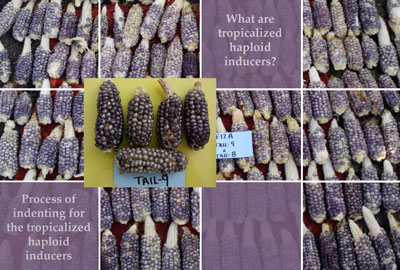 The doubled haploid (DH) technology enables rapid development of completely homozygous maize lines and offers significant opportunities for fast-track development and release of elite cultivars. Besides simplified logistics and reduced costs, use of DH lines in conjunction with molecular markers significantly improves genetic gains and breeding efficiency. DH lines also are valuable tools in marker-trait association studies, molecular marker-assisted or genomic selection-based breeding, and functional genomics.
The doubled haploid (DH) technology enables rapid development of completely homozygous maize lines and offers significant opportunities for fast-track development and release of elite cultivars. Besides simplified logistics and reduced costs, use of DH lines in conjunction with molecular markers significantly improves genetic gains and breeding efficiency. DH lines also are valuable tools in marker-trait association studies, molecular marker-assisted or genomic selection-based breeding, and functional genomics.
Generating DH lines involves four major steps: (1) In vivohaploid induction; (2) haploid seed identification using morphological markers; (3) chromosome doubling of putative haploids; and (4) generating D1 (DH) seed from D0 seedlings. In vivo haploid induction is achieved by crossing a specially developed maize genetic stock called an “inducer” (as male) with a source population (as female) from which homozygous DH lines are developed.
What are tropicalized haploid inducers?
Adoption of DH technology by public maize breeding programs and small- and mediumscale enterprise (SME) seed companies, especially in developing countries, is limited by the lack of inducers adapted to the tropical/subtropical conditions. The CIMMYT Global Maize Program, in collaboration with the Institute of Plant Breeding, Seed Science and Population Genetics of the University of Hohenheim (UHo) now has tropical haploid inducers for sharing with the interested institutions under the terms outlined below.
The tropically adapted inducer lines (TAILs) developed by CIMMYT and UHo showed high haploid induction capacity (~8-10%) and better agronomic performance than temperate inducers, in trials at two CIMMYT experiment stations in Mexico. A haploid inducer hybrid developed using these TAILs revealed heterosis for plant vigor and pollen production under tropical conditions, while maintaining similar haploid induction rates (~8-10%). CIMMYT and UHo decided to share the seed and grant authorization for use of one of the tropicalized haploid inducer lines (one of the parents of a hybrid inducer) and the hybrid inducer to interested applicants, after signing of the relevant material transfer agreement (MTA) and with restrictions to protect the intellectual property rights of both institutions for the inducer lines.
Process of indenting for the tropicalized haploid inducers
Interested applicants should send a letter of intent or an expression of interest in the tropicalized haploid inducers. CIMMYT may seek more information, if required, and will share the relevant MTA template for signing by applicants. The general guidelines to obtain inducers for research use and commercial use are as follows.
For research use by publicly-funded national agricultural research systems
Publicly-funded institutions interested in access to the haploid inducers for specific purposes (e.g., to develop DH lines for breeding programs) may send a letter of intent or expression of interest to CIMMYT. For eligible institutions, the haploid inducers will be provided free-of-charge by CIMMYT and UHo, after signing of a Research Use MTA. Commercial use of the inducers by institutions or others should be in accordance with a separate license agreement for commercial use (as given below).
For commercial use
Applicants may access the inducers for commercial use pursuant to signing of a Material Transfer and License Agreement with CIMMYT and UHo. Applicants shall pay UHo a one-time licence fee of USD 25,000 for provision of seed of two haploid inducers; these include one of the parents of a tropicalized haploid inducer hybrid and the haploid inducer hybrid itself. If applicants wish to access the other parent of the haploid inducer hybrid, an additional one-time licence fee of $10,000 will be payable to UHo.
Acknowledgments
Generous support for joint research on doubled haploids by CIMMYT and the University of Hohenheim has come from the Bill & Melinda Gates Foundation; the Howard G. Buffett Foundation; SAGARPA, the Mexican Ministry of Agriculture, Livestock, Rural Development, Fisheries and Food.; USAID (US Agency for International Development); Dr. Dr. h. c. Herrmann Eiselen and the Foundation fiat panis, Ulm, Germany; the Tiberius Services AG, Stuttgart, Germany; Vilmorin Seed Company; DTMA (Drought Tolerant Maize for Africa) project.;MAIZE CGIAR Research Program; and the International Maize Improvement Consortium (IMIC) project under MasAgro (Sustainable Modernization of Traditional Agriculture).
For further details, please contact:
Dr. BM Prasanna, Director, Global Maize Program, CIMMYT ( b.m.prasanna@cgiar.org), or
Dr. Vijay Chaikam, DH Specialist, Global Maize Program, CIMMYT ( v.chaikam@cgiar.org)
Maize Doubled Haploid Facility for Africa (3.17 MB)
The doubled haploid (DH) technology enables rapid development of completely homozygous maize lines and offers significant opportunities for fast-track development and release of elite cultivars. Besides simplified logistics and reduced costs, use of DH lines in conjunction with molecular markers significantly improves genetic gains and breeding efficiency. DH lines also are valuable tools in marker-trait association studies, molecular marker-assisted or genomic selection-based breeding, and functional genomics.
Generating DH lines involves four major steps: (1) In vivohaploid induction; (2) haploid seed identification using morphological markers; (3) chromosome doubling of putative haploids; and (4) generating D1 (DH) seed from D0 seedlings. In vivo haploid induction is achieved by crossing a specially developed maize genetic stock called an “inducer” (as male) with a source population (as female) from which homozygous DH lines are developed.
What are tropicalized haploid inducers?
Adoption of DH technology by public maize breeding programs and small- and mediumscale enterprise (SME) seed companies, especially in developing countries, is limited by the lack of inducers adapted to the tropical/subtropical conditions. The CIMMYT Global Maize Program, in collaboration with the Institute of Plant Breeding, Seed Science and Population Genetics of the University of Hohenheim (UHo) now has tropical haploid inducers for sharing with the interested institutions under the terms outlined below.
The tropically adapted inducer lines (TAILs) developed by CIMMYT and UHo showed high haploid induction capacity (~8-10%) and better agronomic performance than temperate inducers, in trials at two CIMMYT experiment stations in Mexico. A haploid inducer hybrid developed using these TAILs revealed heterosis for plant vigor and pollen production under tropical conditions, while maintaining similar haploid induction rates (~8-10%). CIMMYT and UHo decided to share the seed and grant authorization for use of one of the tropicalized haploid inducer lines (one of the parents of a hybrid inducer) and the hybrid inducer to interested applicants, after signing of the relevant material transfer agreement (MTA) and with restrictions to protect the intellectual property rights of both institutions for the inducer lines.
Process of indenting for the tropicalized haploid inducers
Interested applicants should send a letter of intent or an expression of interest in the tropicalized haploid inducers. CIMMYT may seek more information, if required, and will share the relevant MTA template for signing by applicants. The general guidelines to obtain inducers for research use and commercial use are as follows.
For research use by publicly-funded national agricultural research systems
Publicly-funded institutions interested in access to the haploid inducers for specific purposes (e.g., to develop DH lines for breeding programs) may send a letter of intent or expression of interest to CIMMYT. For eligible institutions, the haploid inducers will be provided free-of-charge by CIMMYT and UHo, after signing of a Research Use MTA. Commercial use of the inducers by institutions or others should be in accordance with a separate license agreement for commercial use (as given below).
For commercial use
Applicants may access the inducers for commercial use pursuant to signing of a Material Transfer and License Agreement with CIMMYT and UHo. Applicants shall pay UHo a one-time licence fee of USD 25,000 for provision of seed of two haploid inducers; these include one of the parents of a tropicalized haploid inducer hybrid and the haploid inducer hybrid itself. If applicants wish to access the other parent of the haploid inducer hybrid, an additional one-time licence fee of $10,000 will be payable to UHo.
Acknowledgments
Generous support for joint research on doubled haploids by CIMMYT and the University of Hohenheim has come from the Bill & Melinda Gates Foundation; the Howard G. Buffett Foundation; SAGARPA, the Mexican Ministry of Agriculture, Livestock, Rural Development, Fisheries and Food.; USAID (US Agency for International Development); Dr. Dr. h. c. Herrmann Eiselen and the Foundation fiat panis, Ulm, Germany; the Tiberius Services AG, Stuttgart, Germany; Vilmorin Seed Company; DTMA (Drought Tolerant Maize for Africa) project.;MAIZE CGIAR Research Program; and the International Maize Improvement Consortium (IMIC) project under MasAgro (Sustainable Modernization of Traditional Agriculture).
For further details, please contact:
Dr. BM Prasanna, Director, Global Maize Program, CIMMYT ( b.m.prasanna@cgiar.org), or
Dr. Vijay Chaikam, DH Specialist, Global Maize Program, CIMMYT ( v.chaikam@cgiar.org)
To meet the global demand for wheat, wheat yield needs to be increased by 60% by 2050 or 1.6% per year. While scientific evidence suggests that the yield potential could be increased by 50% or more, the research needed is beyond the current capacity of individual institutions or national research programs. Therefore, the establishment of an international Wheat Yield Network (WYN) was proposed on 13 November 2012 during the Wheat Yield Funders’ Conference in Mexico City. The WYN follows on from a major three year effort by the Global Wheat Program and many international partners (who worked together as the Wheat Yield Consortium) with strong support from the Mexican Ministry of Agriculture, Livestock, Rural Development, Fisheries and Food (SAGARPA) through the MasAgro initiative.
The meeting was officially opened by Francisco Javier Mayorga Castañeda, SAGARPA Secretary. Thomas Lumpkin, CIMMYT director general, welcomed all participants on behalf of CIMMYT. Hans Braun, CIMMYT Global Wheat Program director, then provided an overview of the global wheat crisis, stating that increasing wheat yield is currently one of the biggest challenges to food security. However, investments in wheat research are low compared to other major crops, although wheat is currently second to rice as the main calorie source and the most important source of plant protein in human food. To achieve the goals of the proposed WYN – increasing the photosynthetic capacity of wheat, achieving high and stable harvest index and lodging resistance, and establishment of a state-of-the-art breeding platform to deliver new wheat lines from this work to the world – it is necessary not only to connect leading public and private research teams, but also to establish more research platforms in developing countries, such as the Campo Experimental Norman E. Borlaug (CENEB) near Ciudad Obregon, Sonora, Mexico.
During his presentation on the origins of the Wheat Yield Consortium, Lumpkin discussed the importance of wheat for achieving food security and raised the question whether wheat will be able to compete with other crops without increased research funding. “We need to supercharge wheat and make it competitive with maize,” he said. Helene Lucas, Wheat Initiative and INRA international coordinator, offered a global perspective on wheat programs and purpose of Wheat Initiative. Steve Visscher (BBSRC deputy chief executive and chief operating officer) and Saharah Moon Chapotin (division chief for agricultural research, USAID) outlined the public sector position, and John Bloomer (JMB Consulting (Pleshey) Ltd. director) summarized the perspective of the private sector.
Prior to the closed session, a discussion was held to cover possible future steps. It was reiterated by participants that the question is not whether a global platform to support wheat research is needed; the question is how to do it. A communiqué with results of the conference is currently being prepared.
On Monday 12 November CIMMYT and SAGARPA presented the first MasAgro Activities Report 2011-2012 at CIMMYT headquarters in Texcoco, State of Mexico.
In his welcome speech, Thomas Lumpkin stated that he is proud to collaborate with a country that has such a profound vision and a solid commitment to its people and to humanity. He added that he expects that other governments and foundations will follow Mexico’s example and pointed out that India, Nigeria, and Ethiopia have already taken their first steps in that direction.
Jorge Martínez Durán, who described his participation in MasAgro as a farmer, indicated that farmers do not want to be left behind as Mexico goes forward, and that MasAgro has given them the opportunity to make solid advances by providing them with information and training, which he considers to be the best tools for growth.
Participating in the ceremony were the Secretary of Agricultural and Livestock Development of the State of Mexico, Heriberto Ortega Ramírez, and the Secretary of Agriculture, Livestock, Rural Development, Fisheries and Food (SAGARPA), Francisco Mayorga Castañeda, who said that “there is no doubt that MasAgro’s impacts have paved the way for us to face the challenge of increasing production despite adverse climatic conditions, by strengthening research and technological innovation within the framework of national and international collaboration.”
On this point, Bram Govaerts, leader of MasAgro component “Take It to the Farmer,” said that although there is still much to be done, MasAgro has laid down solid bases all along the maize and wheat research, production, and marketing chains, and this will allow Mexico to advance towards having a farm sector that is more productive, prosperous, and sustainable.
To commemorate the occasion, Thomas Lumpkin presented a citation and a statuette of Dr. Norman Borlaug to Secretary Mayorga in recognition of his determined support for implementing a program that has placed Mexico in a position of international leadership in the area of research for food security and sustainable rural development in an environment of climate change.
Also attending the event were farmers, technicians, research cooperators, private sector representatives, federal and local authorities, journalists and representatives of the main international foundations and development agencies, who, all together, totaled 325 guests.
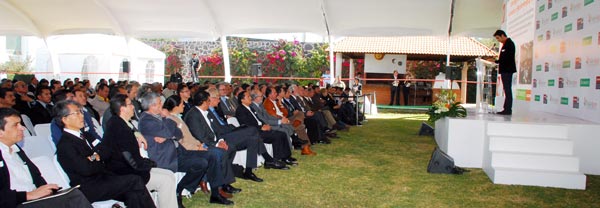
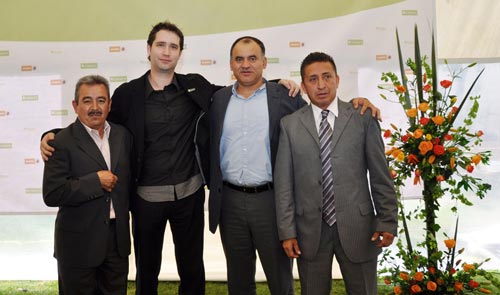 After 12 months of work and dedication, on 19 October 2012 technicians from different parts of Mexico were recognized for their efforts in an August graduation ceremony for the “Technicians Certified in Conservation Agriculture” course. The 48 graduates constitute the third generation of specialists trained to provide technical advice and assistance to new farmers as part of the “Take it to the Farmer” initiative of the Sustainable Modernization of Traditional Agriculture (MasAgro) program.
After 12 months of work and dedication, on 19 October 2012 technicians from different parts of Mexico were recognized for their efforts in an August graduation ceremony for the “Technicians Certified in Conservation Agriculture” course. The 48 graduates constitute the third generation of specialists trained to provide technical advice and assistance to new farmers as part of the “Take it to the Farmer” initiative of the Sustainable Modernization of Traditional Agriculture (MasAgro) program.
Held at CIMMYT-El Batán, the ceremony was attended by dignitaries including Francisco Mayorga Castañeda, Mexico’s Secretary of Agriculture; Mariano Ruiz Funes, Mexican Undersecretary of Agriculture; Bruno Gerard, director of CIMMYT’s global conservation agriculture program; Bram Govaerts, leader of “Take it to the Farmer”; Heriberto Ortega Ramírez, Secretary of Agriculture and Livestock Development for the State of Mexico; and Rodrigo Sánchez Mújica, Director General of the Mexican Trust Funds for Rural Development (FIRA).
In his talk to the graduates and other guests, Mayorga Castañeda highlighted the key role of MasAgro in bringing change to farming in Mexico, thus increasing food production while promoting sustainable development, and said the technicians were central to this occurring: “I hope their activities will be successful and the knowledge they have acquired will be applied, for this will undoubtedly bring positive results for rural Mexico.”
In 2011, more than 12,000 farmers benefitted from the training of 2,500 technicians. “With the support of these newly-trained technicians, we hope to significantly expand the 21,000 hectares currently under conservation agriculture in Mexico,” said Govaerts.
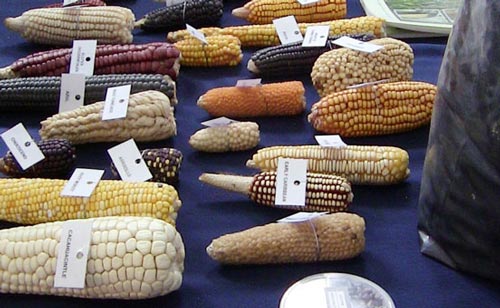 National Service Seed Inspection and Certification (SNICS) and National Plant Genetic Resources for Food and Agriculture (SINAREFI) organized the first Agro-biodiversity and Agroproducts Fair in Xochitla Ecological Park, Tepozotlan, Mexico, during 7-8 September 2012, to promote conservation and sustainable use of genetic resources of crop species which originated in Mexico (maize, squash, bean, avocado, tejocote, poinsettia, and vanilla). Production techniques, crop diversity, biodiversity, handicraft, agro-industrial processing, and culinary products were demonstrated to a large audience of farmers, educators, private entrepreneurs, policy-makers, donors, and international institutions representatives.
National Service Seed Inspection and Certification (SNICS) and National Plant Genetic Resources for Food and Agriculture (SINAREFI) organized the first Agro-biodiversity and Agroproducts Fair in Xochitla Ecological Park, Tepozotlan, Mexico, during 7-8 September 2012, to promote conservation and sustainable use of genetic resources of crop species which originated in Mexico (maize, squash, bean, avocado, tejocote, poinsettia, and vanilla). Production techniques, crop diversity, biodiversity, handicraft, agro-industrial processing, and culinary products were demonstrated to a large audience of farmers, educators, private entrepreneurs, policy-makers, donors, and international institutions representatives.
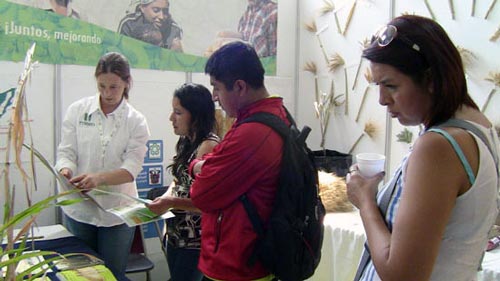 CIMMYT participated in the fair through its Seeds of Discovery (SeeD) initiative under the Genetic Resources Program. Martha Willcox (SeeD maize phenotyping coordinator) and Carolina Saint Pierre (SeeD wheat phenotyping coordinator) presented maize and wheat collections from the CIMMYT genebank and a poster prepared by Paulina González and Bibiana Espinosa from the germplasm bank emphasizing the importance of seed conservation and its long-term benefits for humanity. CIMMYT team was also represented by Isabel Peña, Institutional Relations Head, who provided visitors with information on CIMMYT. The CIMMYT booth was visited by many students, professors, and farmers. The students and professors expressed a particular interest in CIMMYT’s publications on maize and wheat diseases, conservation agriculture, the SeeD initiative, breeding for drought and low nitrogen tolerance, breeding of native maize (criollos), and grain storage techniques. Farmers were mostly interested in CIMMYT maize collections samples. They also shared their experience working with different types of maize.
CIMMYT participated in the fair through its Seeds of Discovery (SeeD) initiative under the Genetic Resources Program. Martha Willcox (SeeD maize phenotyping coordinator) and Carolina Saint Pierre (SeeD wheat phenotyping coordinator) presented maize and wheat collections from the CIMMYT genebank and a poster prepared by Paulina González and Bibiana Espinosa from the germplasm bank emphasizing the importance of seed conservation and its long-term benefits for humanity. CIMMYT team was also represented by Isabel Peña, Institutional Relations Head, who provided visitors with information on CIMMYT. The CIMMYT booth was visited by many students, professors, and farmers. The students and professors expressed a particular interest in CIMMYT’s publications on maize and wheat diseases, conservation agriculture, the SeeD initiative, breeding for drought and low nitrogen tolerance, breeding of native maize (criollos), and grain storage techniques. Farmers were mostly interested in CIMMYT maize collections samples. They also shared their experience working with different types of maize.
The Fair’s program included many interesting presentations. SINAREFI highlighted their conservation networks including custodian farmers of native maize in the states of Sinaloa and Oaxaca. The farmers brought maize ears to demonstrate maize races they produce and maintain on their farms, and discussed the advantages of the dynamic on-site conservation system which allows for farmer selection and adaptation to changing environments. Other members of the agricultural research community were present at the Fair to discuss their recent research activities and demonstrate their products.
The Fair provided opportunities for interaction with local farmers and students from different parts of Mexico, and demonstrated various agro-products and sustainable technologies. CIMMYT’s participation raised public awareness of CIMMYT’s work and created a closer relationship with SNICS and SINAREFI.